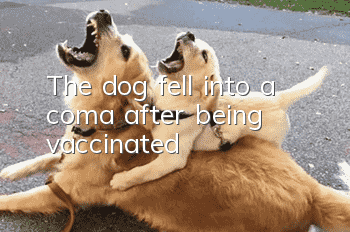The dog fell into a coma after being vaccinated!

Last year, Hangzhou strictly controlled dogs. All dogs must be vaccinated. Various adverse reactions caused by vaccines came one after another. In fact, this phenomenon is quite common, but the severity varies, ranging from itching, vomiting, and diarrhea. , in severe cases, body temperature may rise, difficulty urinating, shortness of breath or even shock and death.
To avoid being at a loss when this phenomenon occurs again, we should first understand about vaccine allergy.
Shock reaction
Allergic reactions can occur within 2 minutes of a dog being vaccinated. In the early stages of shock, the dog will be particularly excited and restless, with a fast heart rate of 70-160 beats/minute, and a respiratory rate increased to 30 times/minute. When the body temperature rises to 39.8-41.0℃, the mucous membranes will become cyanotic (a manifestation of increased deoxygenated hemoglobin in the blood causing the skin and mucous membranes to turn purple), which will last for about 10-15 minutes.
Immediately afterwards, the dog slowly turned from excited and restless to depressed, with sluggish and weak heartbeat, irregular heartbeat, thready and weak pulse, pale mucous membranes, cold limbs, muscle relaxation and weakness, prolonged capillary refill time, difficulty breathing, and Thirst, slow reaction, complete disappearance of pain, visual, and auditory stimulation, pupil dilation, blood pressure drop, and finally coma and death.
Intestinal spasm, abdominal pain, vomiting stress response
It will occur 15-20 minutes after the dog is vaccinated. The dog will have spasmodic abdominal pain, irritability, continuous moaning, and a twitching sensation in the abdominal muscles. If you touch the dog's lower abdomen with the flat surface of your palm, you will feel the intestinal peristalsis and rolling. .
Digestive tract irritation reaction
It occurs on the second day after the dog is vaccinated. The dog begins to have diarrhea, decreased urination, thirst, decreased appetite (or refuses to eat), and is unable to walk.
Febrile reaction
It occurs on the 2nd day after the dog is vaccinated. The skin becomes hot and red, and the body temperature is high (reaching about 39.8℃) (.
Dermatitis reaction
Generally, symptoms of urticaria will appear on the dog’s ears, lower abdomen, and back 3-6 days after vaccination.
· Measure blood pressure. There is no obvious change in the early stages of shock. The blood pressure drops during the shock period. If the blood pressure is lower than 6666Pa, the animal's consciousness disappears; if it continues to drop to 4666Pa and lasts for 2 hours, the animal will become comatose and eventually die.
· Heart rate/pulse rate monitoring, fast heart rate, normalCan reach 160 times/minute.
· Measure central venous pressure, except in cardiogenic shock. When dogs are in shock, the central venous pressure is generally lower than the normal value of 0-5cm water column.
· Measurement of cardiac output, cardiac output decreases.
· When Po2 is measured, the partial pressure of oxygen also decreases.
· To measure capillary filling, gently press the gums or tongue edges with your fingers, and observe the blood flow filling time after the pressure is released. When the dog is in shock, the capillary filling time exceeds the normal value of 1 second.
Anaphylactic shock
It is the most serious type of hypersensitivity reaction and requires symptomatic treatment based on the symptoms mentioned above. If the rescue is not timely, it will cause death.
·Oxygen administration. Dogs in shock must ensure adequate ventilation, maintain oxygen tension, and keep the respiratory tract open. Quickly insert the oxygen bag tube into the dog's nasal cavity and use positive pressure ventilation until the dog breathes normally;
· Medication. Epinephrine hydrochloride 0.1-0.5mL, intramuscular injection (the dose can be adjusted as appropriate according to the dog’s weight and reaction symptoms);
· Intravenous infusion of 250 mL of 0.9% normal saline and 1 mL of chlorpheniramine;
Cramping, abdominal pain, vomiting
· 0.5% atropine sulfate, intramuscular injection at 0.2mL per kilogram of body weight;
· Gastrointestinal administration: 0.5-1.0mL/intramuscular injection (the dose for puppies can be adjusted as appropriate);
Digestive tract reactions (diarrhea, diarrhea, dehydration)
· Gentamicin 80,000-100,000 U/animal, intramuscular injection (the dose for puppies can be adjusted as appropriate);
· 4mL of Quankang treatment solution, intramuscular injection (the dosage for puppies can be adjusted as appropriate);
· 250mL of 0.9% normal saline, 250mL of 5% glucose, if there is bloody stool, add 2mL of Hemostasis, intravenously, once a day, for 3 days;
Febrile reaction
· 10% aminopyrine 2-4mL, intramuscular injection, puppies can use 30% metamizole 1mL intranasally;
· Vitamin C 2-4mL, intramuscular injection (the dose for puppies can be adjusted as appropriate);
Dermatitis reaction
Dermatitis mainly involves itching in the ears and abdomen, and urticaria on the back.
· Oxycortisone, 1-2mL per dog, intramuscular injection, for 3 days (the dose for puppies can be adjusted as appropriate);
· Chlorpheniramine injection 1-2mL/animal, intramuscular injection;
· Hydrocortisone ointment, apply to the affected area;
· Dosage of the synergistic canine pentavalent attenuated vaccine: 1 dose per bottle of vaccine, add 2 mL of water for injection to dissolve each dose before use;
· Immunization program: ① Each dog between 30 and 90 days old should be injected three times in a row, with an injection interval of 2 to 3 weeks. ② Adult dogs should be injected twice a year, with an injection interval of 2 to 3 weeks. ③ The injection method should be Choose subcutaneous or intramuscular injection;
· The canine pentavalent vaccine is a vaccine for dogs, which is highly specific to dogs and has good immune effect, but it is only used for vaccination of confirmed healthy dogs;
· Disinfect the injection site well, one syringe for each dog, and strictly follow the operating procedures;
· It is strictly prohibited to give preventive vaccinations to dogs that are infected during the latent period;
· It is strictly prohibited to give emergency vaccinations and treatments to dogs when an epidemic has occurred;
· For dogs using polyvalent serum, rabies vaccination should be given after 2-3 weeks;
· During the period of rabies vaccination, pet dogs should not be fed frozen and spicy food, should not exercise strenuously, should not be exposed to rain, and should not shower within 6 days. In winter, they should pay attention to heat preservation and try to avoid the above stress reactions
- What causes soft stool in dogs?
- What should I do if my puppy keeps barking when I first get home? A must-read for novice dog trainers!
- Does walking a dog in Alaska require a leash? Things to note when walking an Alaskan dog!
- Why do dogs regurgitate their cud?
- How to make Labrador's hair shiny?
- How long can a Corgi take a bath to repel insects?
- What should I do if my dog’s testicles are rotten?
- How to distinguish between Ala and Husky
- shock! How to save your dog's life after accidentally eating rat poison?
- How to choose a miniature schnauzer



